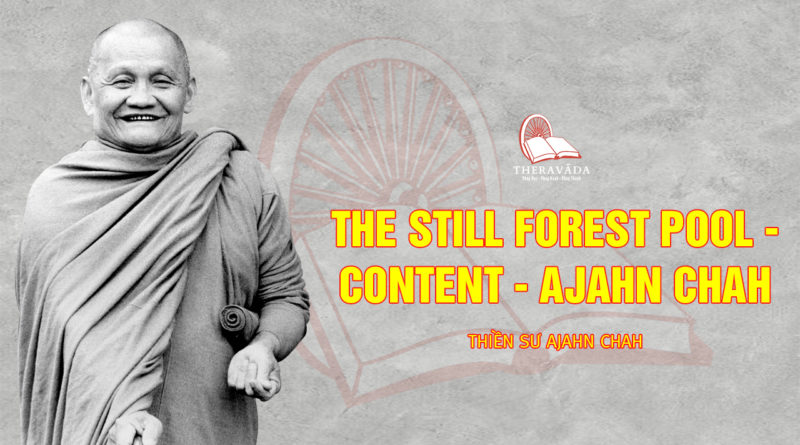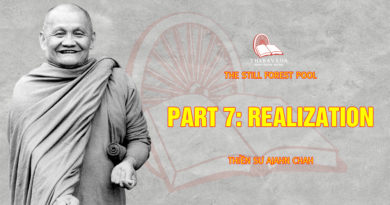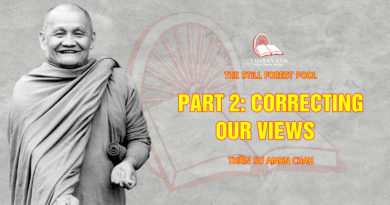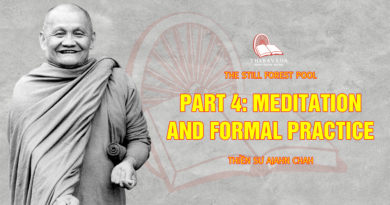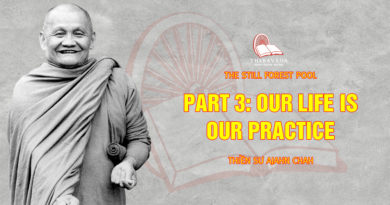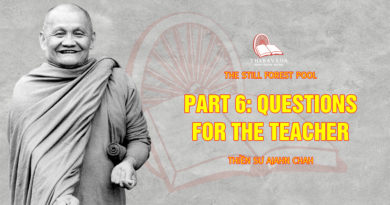CONTENT
PART 1
Understanding the Buddha’s Teachings
The Simple Path
The Middle Way
Ending Doubt
Go Beyond Words : See for Yourself
Buddhist Psychology
Study and Experiencing
The Chicken or the Egg
Thieves in Your Heart
PART 2
Correcting Our Views
The Wrong Road
Right Understanding
Starving Defilements
Happiness and Suffering
The Discriminating Mind
Sense Objects and the Mind
Problems of the World
Just That Much
Follow Your Teacher
Trust Your Heart
Why Do You Practice?
Let the Tree Grow
Too Much of a Good Thing
PART 3
Our Life Is Our Practice
Meditation in Action
To Grasp a Snake
Virtue
The Spiral of Virtue Concentration and Wisdom
What is Natural?
Moderation
Rely on Yourself
Don’t Imitate
Know Yourself – Know Others
Let Others Be
Real Love
Learning Through Life
Oppose Your Mind
Just Let Go
PART 4
Meditation and Formal Practice
Mindfulness
The Essence of Vipassana: Observing Your Mind
Walking Meditation
Who is Sick?
Learning Concentration
Stick to It
Seven Days to Enlightenment
Learning to Chant
Forget About Time
Some Hints in Practicing
Contemplate Everything
The Leaves will Always Fall
PART 5
Lessons in the Forest
A Monk’s Life
Restraint
Rules Are Tools
Go Left, Go Right
Cures for Restlessness
The “Deeper Meaning” of a Chant
The Dharma of Menial Tasks
Harmony with Others
Monk’s Don’t Chatter
Opposing Lust
Scenes Change, but the Mind Remains the Same
Where Can You Run to?
Looking for the Buddha
Rely on Oneself
Keep the Teaching Simple
Learning to Teach
What is The Best Kind of Meditation?
A Wonderful Meal
Achaan Chah’s Cottage
Holy Ceremonies and Hot Days
The Real Magic
Practice of the Householder
PART 6
Questions for the Teacher
Questions and Answers
PART 7
Realization
Not-Self
Short and Straight
Underground Water
The Joy of the Buddha
Picking Up Mangoes
The Timeless Buddha
Yes, I Speak Zen
The Unstuck Gong
Nothing Special
Inside You is Nothing, Nothing at All
In Ending
____________________
INTRODUCTION
Suppose you were to go to Asia in the 1980s in search of living teachings of the Buddha, to discover if there are still monks and nuns practicing a life of simplicity and meditation, supported by alms-food, and dwelling in the forest. Perhaps you had read descriptions of the Buddha himself wondering with his monks in the forests of India, inviting men and women of good families to join him in cultivating wisdom and universal compassion, inviting them to live the simple life of a mendicant, to dedicate themselves to inner calm and awareness. Would you find this way of life alive today, twenty-five centuries later? And would its teachings still be applicable and relevant for-our modem society, our modem minds?
You would land at a modem airport near Bangkok or Colombo or Rangoon. In your taxi you would drive through Asian city streets, passing cars, crowded busses, sidewalk vendors of tropical fruits. Every few blocks you would see the golden pagoda or spire of an urban Buddhist temple. But these are not the temples you have come to search for. They contain monks and nuns who study the ancient texts, who can chant and preach, and from this they teach. But to find the simple life of dwelling in the forest, the meditative living with robe and bowl, as old as the Buddha himself, you would have to leave the cities and their temples far behind. If it were Thailand, the country with the greatest number of monasteries and monks, you would board the train at busy Hualampong station, leaving early in the morning for the provinces of the far south or northeast.
The first hour’s journey would take you clear of the urban sprawl, beyond the houses, businesses, and shanties backed up along the railway track. Vast plains of central Thailand would roll by, the green rice bowl of Southeast Asia. Mile after mile of paddy fields, checkerboarded into lots by small dikes between fields and rhythmically divided by canals and waterways. On the horizon of this sea of rice, every few miles in four or five directions you would see islands-dense clusters of palm and banana trees. If your train rolled close enough to one of these palm islands, you would see the glint of an orange-roofed monastery and cluster of wooden houses on stilts that make up a Southeast Asian village.
Every settled village, whether with five hundred or two thousand residents, has at least one monastery. It serves as the place for prayer, for ceremony, as the meeting hall, and for many years also served as the village school. Here is the place where most young men of the village will ordain at age twenty, for one year or three months, to learn enough of the ways of the Buddha to “ripen” into mature members of their society. The monastery is probably run by a few older, simple, and well-meaning monks who have studied some of the classic texts and know enough of ceremonies and of the basic teachings to serve as village priests. This monastery is an integral and beautiful part of village life, but it is not the temple you have come to search for.
Your train heads north toward the ancient capitol of Auddhaya, filled with the ruins of magnificent temples and ‘broken palaces that were sacked centuries ago in the periodic wars with neighboring kingdoms. The spirit of these magnificent ruins remains in the enormous stone Buddhas, imperturbably weathering the centuries.
Now your train turns east for the long journey toward the Lao border, across the reaches of the Korat Plateau. Hour after hour the land passes. Still you see rice paddies and villages, but they gradually become sparser and poorer. The canals and lush gardens of Central Thai villages, mango trees, and tropical greenery turn into a simpler landscape. Houses are smaller. Village monasteries still gleam, but they too are smaller and simpler. Here an older, more self-sufficient way of life is preserved. You can see women weaving hand loomed blankets on their porches, while rice farmers work and children tend the water buffalo in wet gullies alongside the railroad tracks.
The rural countryside in these lesser developed provinces holds much of what remains of the tradition of forest monks and nuns. It still has regions of forest and jungle, small thickly covered mountains, and unsettled borderlands. And for many centuries it has supported forest monks and monasteries dedicated to the preservation and realization of the enlightenment of the Buddha. For the most part these monks do not function as village priests, nor do they teach school, nor study and preserve the language of the ancient written scriptures. Their intent is to live fully and realize in their own hearts and minds the insight and inner peace taught by the Buddha.
If you left the train and made your way by bus or hired car down some dirt road to such a monastery, one of dozens in northeast Thailand, what would you find? Would the teachings and way of practice be relevant in the 1980s? Would the insight and awareness training address the needs of one coming from a modern and complex society?
You would discover that many Westerners had come before you. Since 1965 hundreds of Europeans and Americans like you have come to visit and learn in the forest. Some came to study for short periods and then returned home to integrate what they learned into their household life. Some came to train more thoroughly as monks for one, two, or more years and then return home. Another group found life in the forest to be a rich and compelling way to live, and these remain in monasteries to this day.
For each of these groups the teachings have spoken directly to their hearts and minds, offering them a wise and conscious way to live. At first the way may seem almost easy, deceptively simple. But upon attempting to put the Buddha’s way into practice, one discovers that it is not so easy. Yet, despite the effort it takes, these people feel that nothing could be more valuable than to discover the Dharma* or truth in one’s own life.
From the moment of your entry into a forest monastery like Wat Ba Pong, the spirit of practice is evident. There is the stillness of trees rustling and the quiet movement of monks doing chores or mindful walking meditation. The whole monastery is spread over a hundred acres, divided into two sections form monks and nuns. The simple unadorned cottages are individually nestled in small forest clearings so that there are trees and silent paths between them. In the central area of the Wat are the main teaching hall, dining area, and chapel for ordination. The whole forest setting supports the atmosphere of simplicity and renunciation. You feel that you have finally arrived.
The monks who live in those monasteries have chosen to follow this uncomplicated and disciplined way of practice called dhudanga. The tradition of forest monks who voluntarily choose to follow a more austere way of life dates back to the Buddha, who allowed a supplementary code of thirteen special precepts, limiting the robes, food, and dwellings of monks. At the heart of this life style are few possessions, much meditation, and a once-daily round of alms-food begging. This way of life spread with the rest of Buddhism into the thick forests of Burma, Thailand, and Laos, places filled with caves and wild terrain, ideal for such intensive practice. These ascetic monks have traditionally been wanderers, living singly or in small groups, moving from one rural area to another, and using handmade cloth umbrella tents hung from trees as their temporary abode. Practical Dharma teachings from one of the greatest forest monasteries, Wat Ba Pong, and its master Achaan Chah have been translated and compiled and are offered to the West in this book.
Achaan Chah and his teachers, Achaan Tong Rath and Achaan Mum, themselves spent many years walking and meditating in these forests to develop their practice. From them and other forest teachers has come a legacy of immediate and powerful Dharma teachings, directed not toward ritual Buddhism or scholastic learning, but toward those who wish to purify their hearts and vision by actually living the teachings of the Buddha.
As great masters emerged in this forest tradition, laypersons and monks sought them out for teaching advice. Often, to make themselves available, these teachers would stop wandering and settle in a particular forest area where a dhudanga monastery would grow up around them. As population pressures have increased in this century, fewer forest areas are left for wanderers, and these forest monastery preserves of past and current masters are becoming the dwelling place of most ascetic and practice-oriented monks.
Wat Ba Pong monastery developed when Achaan Chah, after years of travel and meditation study, returned to settle in a thick forest grove near the village of his birth. The grove, uninhabited by humans, was known as a place of cobras, tigers, and ghosts-the perfect location for a forest monk, according to Achaan Chah. Around him a large monastery grew up.
From its beginnings as a few thatched huts in the forest, Wat Ba Pong has developed into one of the largest and best-run monasteries in Thailand. As Achaan Chah’s skill and fame as a teacher have become widespread, the number of visitors and devotees has rapidly increased. In response to requests from devotees throughout Thailand, over fifty branch monasteries under the guidance of abbots trained by Achaan Chah have also been opened, including one near Wat Ba Pong especially designed for the many Western students who have come to seek Achaan Chah’s guidance in the teachings. In recent years several branch monasteries and associated centers have been opened in Western countries as well, most notably the large forest Wat at Chithurst, England, run by Abbot Sumedho, Achaan Chah’s Senior Western disciple.
Achaan Chah’s teachings contain what has been called “the heart of Buddhist meditation,” the direct and simple practices of calming the heart and opening the mind to true insight. This way of mindfulness or insight meditation has become a rapidly growing form of Buddhist practice in the West. Taught by monks and laypeople who have themselves studied in forest monasteries or intensive retreat centers, it provides a universal and direct way of training our bodies, our hearts, and our minds. It can teach us how to deal with greed and fear and sorrow and how to learn a path of patience, wisdom, and selfless compassion. This book is meant to provide guidance and counsel for those who wish to practice.
Achaan Chah’s own practice started early in life and developed through years of wandering and austerity under the guidance of several great forest masters. He laughingly recalls how, even as a child, he wanted to play monk when the other children played house and would come to them with a make believe begging bowl asking for candy and sweets. But his own practice was difficult, he relates, and the qualities of patience and endurance he developed are central to the teachings he gives his own disciples. A great inspiration for Achaan Chah as a young monk came from sitting at his father’s sickbed during the last days and weeks of his father’s life, directly facing the fact of decay and death. ‘When we don’t understand death,” Achaan Chah teaches, “life can be very confusing.” Because of this experience, Achaan Chah was strongly motivated in his practice to discover the causes of our worldly suffering and the source of peace and freedom taught by the Buddha. By his own account, he held nothing back, giving up everything
for the Dharma, the truth. He encountered much hardship and suffering, including doubts of all kinds as well as physical illness and pain. Yet he stayed in the forest and sat-sat and watched-and, even though there were days when he could do nothing but cry, he brought what he calls a quality of daring to his practice. Out of this daring eventually grew wisdom, a joyful spirit, and an uncanny ability to help others.
Given spontaneously in the Thai and Lao languages, the teachings in this book reflect this joyful spirit of practice. Their flavor is clearly monastic, oriented to the community of men who have renounced the household life to join Achaan Chah in the forest. Hence frequent reference is made to he rather than he or she, and the emphasis is on the monks (an active community of forest nuns also exists) rather than laypersons. Yet the quality of the Dharma expressed here is immediate and universal, appropriate to each of us. Achaan Chah addresses the basic human problems of greed, fear, hatred, and delusion, insisting that we become aware of these states and of the real suffering that they cause in our lives and in our world. This teaching, the Four Noble Truths, is the first given by the Buddha and describes suffering, its cause, and the path to its end.
See how attachment causes suffering, Achaan Chah declares over and over. Study it in your experience. See the ever-changing nature of sight, sound, perception, feeling, and thought. Understanding the impermanent, insecure, selfless nature of life is Achaan Chah’s message to us, for only when we see and accept all three characteristics can we live in peace. The forest tradition works directly with our understanding of and our resistance to these truths, with our fears – and anger and desires. Achaan Chah tells us to confront our defilements and to use the tools of renunciation, perseverance, and awareness to overcome them. He urges us to learn not to be lost in our moods and anxieties but to train ourselves instead to see clearly and directly the true nature of mind and the world.
Inspiration comes from Achaan Chah’s clarity and joy and the directness of his ways of practice in the forest. To be around him awakens in one the spirit of inquiry, humor, wonderment, understanding, and a deep sense of inner peace. If these pages capture a bit of that spirit in their instructions and tales of the forest life and inspire you to further practice, then their purpose is well served.
So listen to Achaan Chah carefully and take him to heart, for he teaches practice, not theory, and human happiness and freedom are his concerns. In the early years when WatBa Pong was starting to attract many visitors, a series of signs was posted along the entry path. “You there, coming to visit,” the first one said, “be quite We’re trying to meditate.” Another stated simply, “To practice Dharma and realize truth is the only thing of value in this life. Isn’t it time to begin?” In this spirit, Achaan Chah speaks to us directly, inviting us to quiet our hearts and investigate the truth of life. Isn’t it time that we begin?
————
Bài viết được trích từ Cuốn The Still Forest Pool, tác giả Thiền Sư Ajahn Chah
* Link Sách: The Still Forest Pool
* Link Tải sách ebook: The Still Forest Pool
* Link Video: The Still Forest Pool
* Link Audio: The Still Forest Pool
* Link Thư mục Tác giả Thiền sư Ajahn Chah
* Link Thư mục Ebook Thiền sư Ajahn Chah
* Link Giới thiệu tác giả Thiền sư Ajahn Chah
* Link Tải App mobile Ứng Dụng Phật Giáo Theravāda

